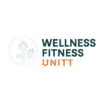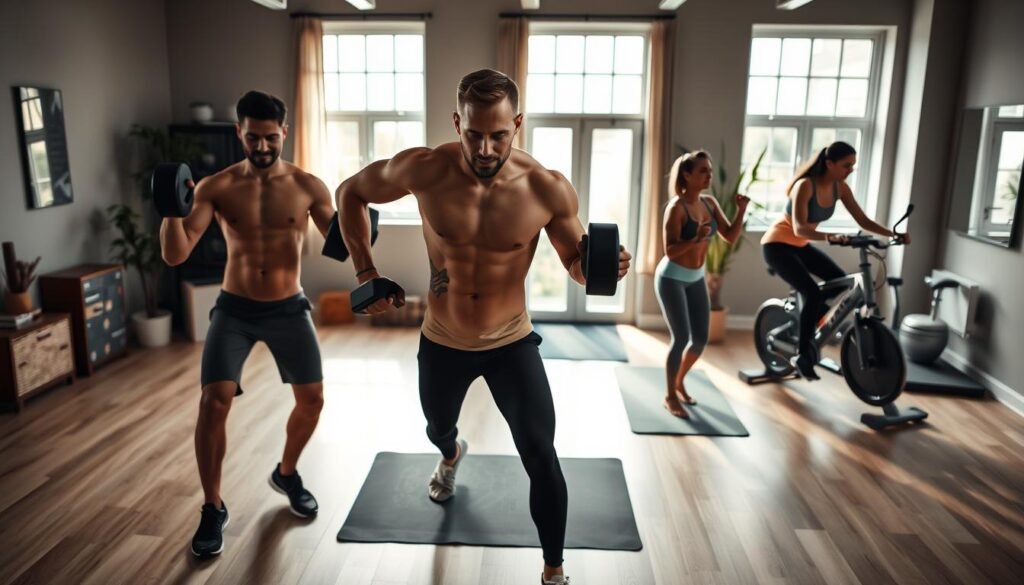Life today is fast-paced. Work, family, and social life fill our days. Yet, exercise is key for energy and health. The answer? Time-efficient routines that work in minutes, not hours.
Studies show 10-minute sessions can boost heart health and strength. High-intensity interval training (HIIT) mixes short, intense workouts with rest. It burns calories fast, fitting into tight schedules. For those who prefer gentle exercises, bodyweight workouts or yoga are great. They’re easy to do anywhere, anytime.
The secret is being regular, not long. GQ’s guide to best workouts for busy lives shows focused exercises and smart planning lead to lasting habits. A quick circuit at lunch or morning stretches can make a big difference.
Key Takeaways
- Short exercise sessions can be as effective as longer workouts when properly designed
- HIIT and bodyweight training adapt well to time constraints
- Consistency matters more than workout length for long-term results
- Morning routines help ensure exercise doesn’t get overshadowed by daily tasks
- Variety prevents boredom and targets different muscle groups efficiently
Introduction to Quick Workouts
Modern fitness isn’t about long gym sessions. It’s about working smarter, not longer. The American College of Sports Medicine (ACSM) says 10-minute bursts of activity can boost heart health as well as long workouts. With 43% of U.S. adults saying they’re too busy for exercise, quick workouts are key for staying healthy.
Understanding the Need for Quick Workouts
Time is a big issue for 58% of full-time workers, the Bureau of Labor Statistics shows. This has changed how we think about fitness:
| Traditional Approach Modern Solution Key Difference | ||
| 60-minute gym sessions | 10-minute home workouts | Time efficiency |
| Equipment-heavy routines | Bodyweight exercises | Accessibility |
| 3 weekly workouts | Daily micro-sessions | Consistency |
“Short bouts of exercise throughout the day can provide similar health benefits to continuous training when accumulated.”
Benefits of Short Exercise Sessions
Quick workouts offer big benefits beyond saving time:
- Improved metabolic rate: Short, intense workouts increase calorie burn for hours after.
- Reduced mental fatigue: 15-minute sessions boost focus better than caffeine for office workers.
- Higher adherence: 78% of people stick with 10-minute routines, compared to 32% for hour-long ones.
These benefits are why 62% of fitness apps now offer express workout options. Whether it’s a morning routine or breaking up work hours, short sessions fit into our busy lives.
High-Intensity Interval Training (HIIT)
HIIT is great for rapid fitness sessions because it’s intense but short. It’s different from steady cardio because it mixes hard work with rest. This combo burns calories fast and boosts your metabolism.
Research shows HIIT can be up to 6 times more effective than regular workouts. It saves time but still gives great results.
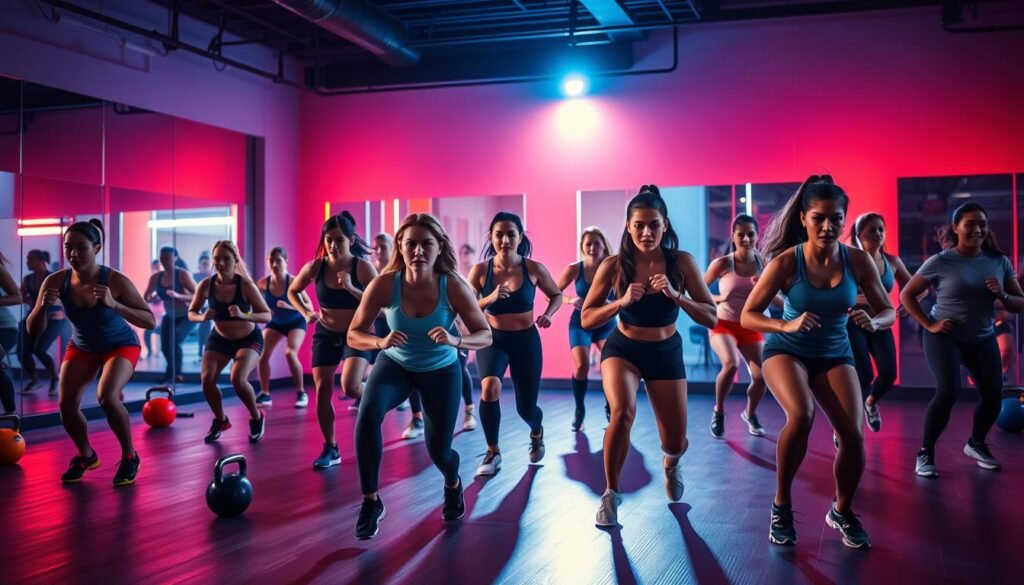
What is HIIT?
HIIT means doing your best for a short time, then resting or doing something easy. For example, sprinting for 30 seconds and then walking for 60 seconds. This quick increase in heart rate leads to burning calories for hours after you stop.
ACE Fitness says HIIT is 30% more efficient than jogging. It averages 8–12 METs, while jogging is 7 METs.
| Exercise Type | Average METs | Intensity Level |
|---|---|---|
| HIIT Sprints | 12 | High |
| Cycling (Moderate) | 7 | Medium |
| Bodyweight Circuits | 9 | High |
| Yoga | 3 | Low |
Sample HIIT Workouts
Here are workouts for different fitness levels. No equipment? Use chair step-ups or water bottles as weights.
- Beginner: 20 seconds jumping jacks / 40 seconds rest (Repeat 8x)
- Intermediate: 30 seconds burpees / 30 seconds plank hold (Repeat 6x)
- Advanced: 45 seconds mountain climbers / 15 seconds rest (Repeat 10x)
Tips for Effective HIIT Sessions
ACE Fitness has some safety tips:
- Warm up for 5 minutes with dynamic stretches
- Keep sessions under 30 minutes to avoid overtraining
- Hydrate before, during, and after workouts
Use a heart rate monitor to track your progress. Aim for 80–90% of your max heart rate during intense intervals. Rest 1–2 days a week to let your muscles recover.
Bodyweight Exercises for Any Time
Busy days mean we need quick workouts. Bodyweight exercises are perfect because they need no setup. They use your body’s weight to build strength, improve movement, and burn calories. Plus, they’re easy to adjust for any fitness level.
Top Bodyweight Exercises to Try
Learn these eight basic moves to make many workout options:
- Push-Ups (Try diamond or plyometric push-ups)
- Bodyweight Squats (Move to pistol squat variations)
- Plank Shoulder Taps (Try spiderman planks)
- Reverse Lunges (Try jumping lunges)
- Glute Bridges (Increase with single-leg versions)
- Burpees (Make it easier by stepping back instead of jumping)
- Mountain Climbers (Make it harder with cross-body knee drives)
- Tricep Dips (Get tougher with straight-leg versions)
Creating Your Own Routine
Make your own AMRAP (As Many Rounds As Possible) circuits with this guide:
- Pick 4-6 exercises from the list above
- Set a timer for 7-15 minutes
- Do 10-15 reps for each exercise
- Keep going without stopping
Space requirements: Most routines need just a 6×6 ft area. This is great for small spaces like apartments or hotel rooms. Always check for overhead clearance when doing jumping movements.
Injury prevention tips:
- Warm up with dynamic stretches for 3 minutes
- Keep your spine straight during exercises
- Take 1-2 rest days a week for recovery
Quick Cardio Options
When time is tight, efficient fitness plans focus on cardio that works fast. Whether it’s a quick lunch break workout or a morning boost, these three options are great. Here’s how they compare:
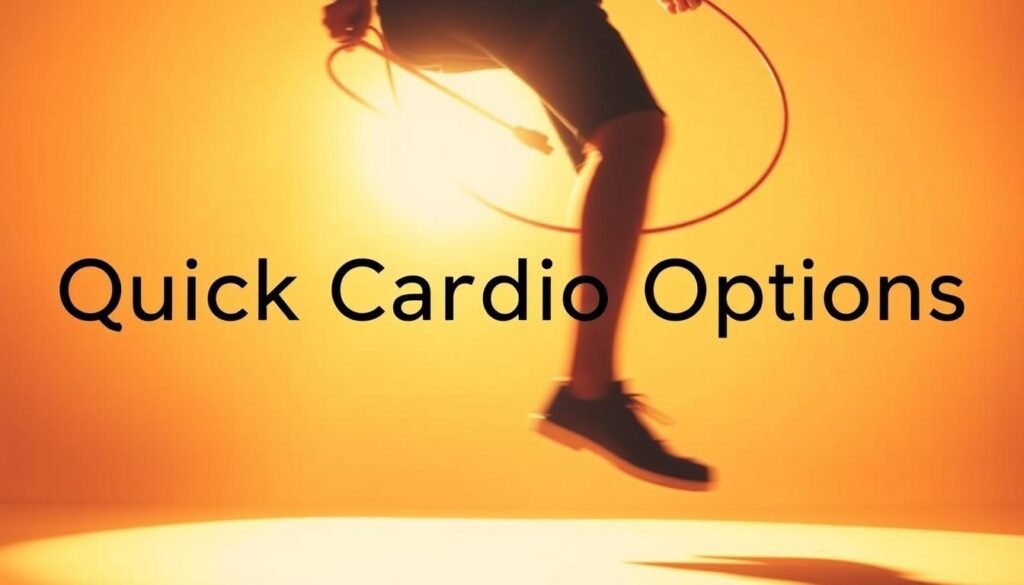
| Activity | Calories Burned* | Intensity Level |
|---|---|---|
| Jump Rope | 120-140 | High |
| Stair Climbing | 90-110 | Moderate-High |
| Running (Sprints) | 130-150 | Very High |
| Cycling | 70-90 | Moderate |
*Based on a 155-pound person; 10-minute session.
Jump Rope Workouts
Jumping rope is more than just for kids—it’s a top choice for efficient fitness plans. Try different moves like basic bounces, single-leg hops, and double-unders. Start with 30 seconds of work followed by 15 seconds of rest for beginners.
For those who are more advanced, try pyramid sets. Increase your speed every minute for 5 minutes, then slow down. This improves coordination and burns calories. Add it to other cardio exercises at home for a complete workout.
Stair Climbing Routines
Turn office or apartment stairs into a gym with these tips:
- Single-step ascents: Climb steadily for 2 minutes, then walk down.
- Skip-step bursts: Take two steps at a time for 1 minute to work your glutes.
- Lateral climbs: Side-step up the stairs to target your outer thighs.
Change up these moves to stay interested. A 15-minute session can burn as many calories as a mile-long jog!
10-Minute Running Blasts
Short running sessions focus on heart rate zone targeting. Start with a 2-minute warm-up, then alternate between 30-second sprints and 1-minute jogs. Use a fitness tracker to keep your heart rate in the 70-85% zone for best fat burn.
No treadmill? Try hill repeats outdoors. Sprint uphill for 20 seconds, then walk down and repeat. This builds endurance without needing a lot of time.
Strength Training on a Tight Schedule
Even with a busy schedule, you can still work on your strength. Use short workout strategies to build muscle and boost endurance in under 20 minutes. Focus on exercises that work many muscles at once. Use dumbbells and resistance bands, which are great for small spaces.
Quick Dumbbell Exercises
Dumbbells are perfect for quick workouts. Here are five exercises that work many muscles:
- Goblet Squats: Hold a dumbbell vertically against your chest while squatting
- Renegade Rows: Assume a plank position, rowing one dumbbell at a time
- Thrusters: Combine front squats with overhead presses in one fluid motion
- Single-Arm Swings: Engage your core and glutes with explosive hip hinges
- Floor Presses: Lie on the floor to bench press, eliminating setup time
To work more efficiently, do supersets. Alternate thrusters with renegade rows. Rest only after finishing both. This keeps your workout intense and short.
Resistance Band Workouts
Bands are great for strength training anywhere. Use this chart to match band colors with dumbbell weights:
| Band Color | Equivalent Dumbbell | Best For |
|---|---|---|
| Yellow | 5-10 lbs | Shoulders & arms |
| Green | 15-20 lbs | Rows & chest presses |
| Blue | 25-30 lbs | Glutes & leg work |
Make full-body circuits with banded squats, seated rows, and overhead presses. Since bands provide constant tension, limit workouts to 4 days a week. Pro tip: Use bands anchored to doors or furniture for pull movements.
Incorporating Stretching into Your Day
Stretching is often overlooked in fitness plans, but it’s very flexible for busy lives. You can stretch between meetings or after work. Short sessions improve your mobility and mental focus without taking up much time.
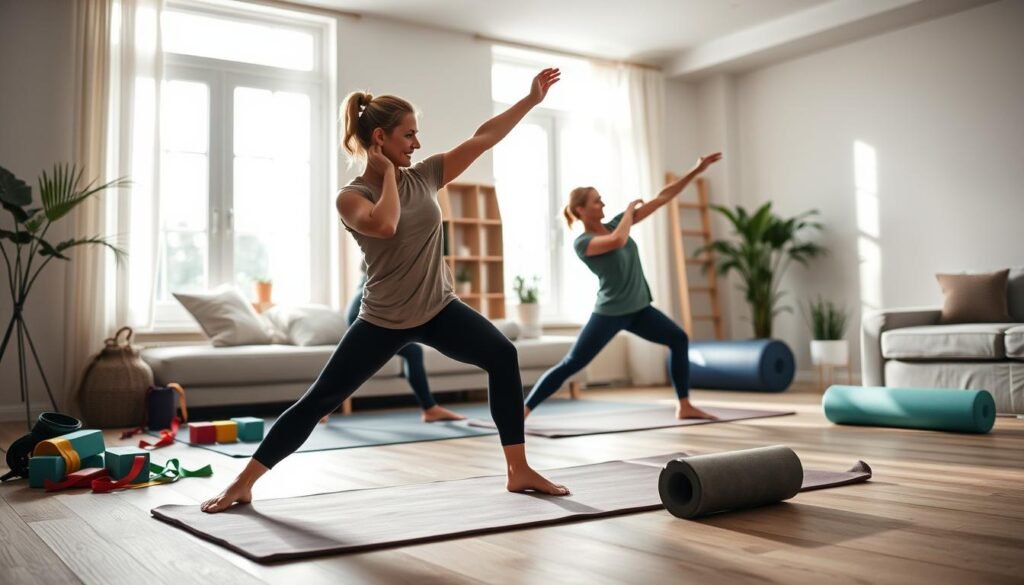
Benefits of Stretching
Micro-stretching sessions as short as 3-5 minutes offer big benefits. They increase blood flow, reduce muscle stiffness, and improve posture. For those who sit a lot, these quick routines help prevent hunched shoulders and tight hips.
Research shows that short stretching breaks can:
- Lower stress hormones by 15%
- Improve joint range of motion by 20%
- Enhance focus during mentally demanding tasks
Quick Stretching Routines
These three routines fit easily into your day. Remember, frequency over duration is key. Even short sessions every 2-3 hours are better than one long stretch a day.
Morning Energizer (4 minutes)
- Cat-Cow flow (30 seconds)
- Standing side reaches (45 seconds/side)
- Forward fold with shoulder release (1 minute)
Midday Reset (3 minutes)
- Seated spinal twist (40 seconds/side)
- Wrist/forearm stretches (1 minute)
- Neck rolls (30 seconds)
Evening Recovery (5 minutes)
- Child’s pose with arm walkouts (1 minute)
- Legs-up-the-wall pose (2 minutes)
- Supine spinal twist (1 minute/side)
For the best results, combine these convenient exercise programs with staying hydrated and deep breathing. It’s more important to be consistent than perfect. Even a little stretching is better than none at all.
Getting Fit in the Office
Staying active at work doesn’t need a gym or loud machines. Stealth workout techniques help you stay energized and flexible without leaving your desk. These methods fit right into office life and work well.
Desk Exercises for Busy Professionals
Try these simple moves to stay active during meetings or when you’re focused:
- Seated leg extensions: Lift one leg parallel to the floor, hold for 5 seconds, then switch
- Desk push-ups: Place hands shoulder-width on your desk and perform 10-15 reps
- Chair squats: Stand up/sit down slowly 12 times to engage glutes and thighs
For quiet exercises, consider these tools:
| Equipment | Noise Level | Portability |
|---|---|---|
| Resistance Bands | Silent | Fits in drawer |
| Under-Desk Pedal | Low hum | Fits under chair |
| Grip Strengthener | Silent | Palm-sized |
Lunchtime Workouts You Can Do
Use a 25-minute break with this simple plan:
- 5-minute brisk walk around the building
- 3 rounds of: 10 incline push-ups (using a bench), 15 bodyweight squats, 30-second plank
- 5-minute stretching cooldown
Many companies now support corporate wellness programs. Suggest these ideas to HR:
- Walking meeting routes in nearby parks
- On-site yoga sessions during lunch hours
- Standing desk conversion kits for teams
Utilizing Technology for Quick Workouts
Smartphones and wearables have changed how we do fast exercise routines. They make it simple to keep up with workouts. Tech tools help track progress and guide you, making sure you stay on track. Let’s see how apps, videos, and devices can help you use your time wisely.
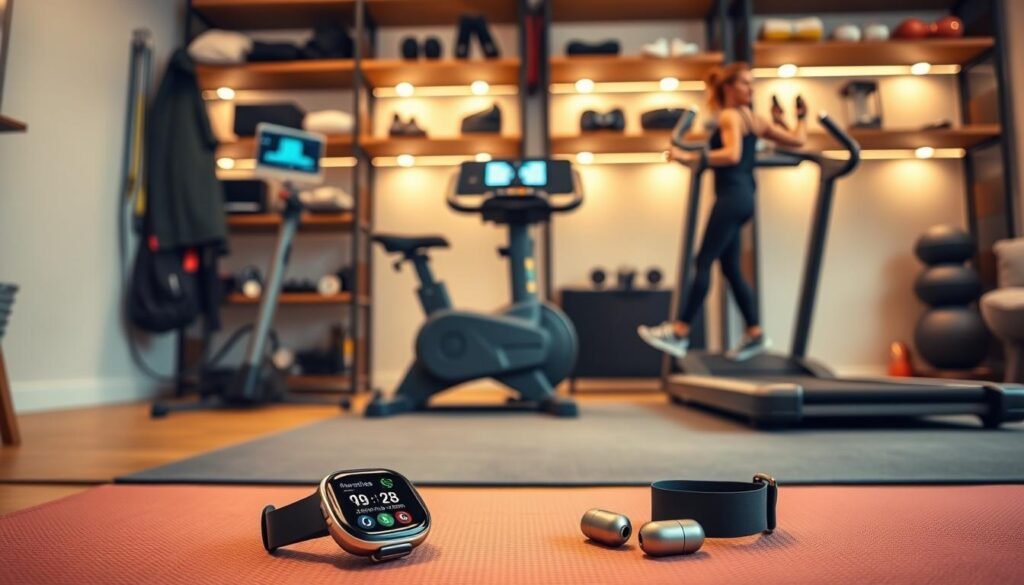
Fitness Apps and Their Benefits
Apps like Nike Training Club and Freeletics offer tailored plans for fast exercise routines. We looked at seven top apps:
- Nike Training Club: Free 20-minute strength sessions with smartwatch integration
- Freeletics: AI-powered bodyweight workouts (3-15 minutes)
- FitOn: Celebrity-led cardio bursts (as short as 5 minutes)
- Seven: 7-minute scientific workouts with rest timers
Smartwatches help by tracking your heart rate during quick workouts. For example, an Apple Watch paired with Peloton app keeps you in the right zone for 10-minute cycling.
Online Workout Videos and Resources
YouTube channels like FitnessBlender and POPSUGAR Fitness offer workouts by duration. They’re great for 5-15 minute fast exercise routines. The benefits include:
- Free access to professional trainers
- Variety across yoga, HIIT, and dance
- Pause/replay features for home use
Virtual coaching platforms like Future ($150/month) offer personalized plans. They’re best for busy people needing motivation. But, free app combinations can give you most of the benefits without spending a dime.
Early Morning Quick Workouts
Starting your day with exercise does more than just burn calories. It syncs your body with your natural energy levels. Morning workouts tap into your body’s natural rhythms, boosting alertness and performance.
Even short workouts, like 15 minutes, can improve your day. They increase productivity, mood, and how well your body uses energy.
Planning a Morning Routine
Consistency beats duration when building a lasting habit. Wake up 30 minutes earlier and do 3-4 workouts a week. Get your workout clothes and gear ready the night before to save time.
Choose light snacks before working out, like half a banana or almond butter toast. Avoid big meals that slow you down. Caffeine? A small black coffee 20 minutes before can help you focus without jitters.
- 5:30 AM: Hydrate with water
- 5:35 AM: Dynamic stretches
- 5:40 AM: Core-focused circuit
Energizing Workouts to Kickstart Your Day
Start with low-impact exercises to avoid stiff joints. Try yoga or resistance band workouts to warm up muscles. For a boost, add squats, mountain climbers, and plank shoulder taps.
Here’s a 12-minute routine:
- 3 minutes: Jumping jacks (moderate pace)
- 3 minutes: Alternating lunges
- 3 minutes: Push-up variations
- 3 minutes: Cool-down stretches
Finish with a protein shake or Greek yogurt to keep energy up until lunch. Use apps like Fitbod or Apple Fitness+ to track your progress and stay motivated.
Evening Workouts for Busy Individuals
Evening workouts are great for those with tight schedules. They help you stay fit without giving up your free time. These time-saving workouts also reduce stress and improve sleep. They make the transition from work to rest easier.
Wind Down with Quick Evening Routines
Evening exercise should calm you down, not energize you. Choose activities that lower stress and gently raise your heart rate. Here are some tips:
- Stress-relief sequences: 10 minutes of yoga flows or tai chi to release tension
- Moderate cardio: A brisk walk or slow cycling session (20-30 minutes)
- Dynamic stretching: Combine mobility work with deep breathing exercises
What you eat after exercise is important, even in the evening. Opt for simple, sleep-friendly snacks:
- A small handful of almonds with tart cherry juice
- Greek yogurt with magnesium-rich pumpkin seeds
- Herbal tea paired with a banana
Finding Balance After a Long Day
It’s key to balance exercise with rest. Here’s a comparison to help you plan your evenings:
| Activity | Duration | Benefit |
|---|---|---|
| Evening walk | 15-20 mins | Lowers stress hormones |
| Bodyweight circuit | 12 mins | Boosts metabolism |
| Guided meditation | 10 mins | Improves sleep quality |
“The best evening workout is one that leaves you energized yet relaxed – it’s about movement, not exhaustion.”
To improve sleep, focus on these tips:
- Finish workouts 90 minutes before bedtime
- Use blue-light blocking glasses after exercise
- Keep your bedroom cool, between 60-67°F
Family-Friendly Quick Workouts
Exercise can be a fun way to bond with your family. These convenient exercise programs help parents and kids stay active together. They’re designed for all skill levels, making it easy to keep everyone moving.
Involving Kids in Your Fitness Routine
Children learn by watching adults, making exercise a great way to teach them. Here are tips for different ages:
- Ages 3-6: Make squats into “frog jumps” and planks into “animal crawls”
- Ages 7-12: Set up obstacle courses with timed challenges
- Teens: Try partner exercises like medicine ball passes
Always make sure kids are safe by adjusting the intensity. For groups with different ages, use stations where everyone can do activities that fit their level. Busy moms can mix 10-minute workouts with playtime by adding resistance bands to playground visits.
Fun Family Activities for Exercise
Turn games into workouts:
- Dance party intervals (3 minutes fast, 1 minute slow)
- Backyard relay races with water balloon passes
- Nature scavenger hunts with exercise rewards
Workouts that involve everyone are best when they teach something new. Count reps in different languages, talk about muscles during stretching, or calculate heart rate percentages during the workout. This keeps everyone’s mind and body active.
Making the Most of Your Weekend
Weekends are a great chance to refresh your body and mind with exercise. With a bit of creativity, you can make these days boost your fitness for the week ahead.
Short Weekend Fitness Challenges
48-hour fitness sprints give you a plan without taking over your schedule. Here are some ideas:
- Do 100 push-ups, 150 squats, and 5 minutes of planking over Saturday and Sunday
- Alternate 10-minute yoga with 15-minute walks every 4 hours
- Use free apps like Nike Training Club to track your progress
See how different activities burn calories by looking at MET values:
| Activity | MET Value | 150-lb Person (Calories/Hour) |
|---|---|---|
| Leisurely biking | 4.0 | 272 |
| Trail running | 9.0 | 612 |
| Rock climbing | 11.0 | 748 |
Outdoor Activities that Count as Workouts
Adjust your rapid fitness sessions to the season:
- Summer: Start with beach bootcamps using resistance bands
- Fall: Go on leaf-peeping hikes with weighted vests
- Winter: Try snowshoeing at local parks
Stay motivated with social plans:
- Plan Saturday morning pickleball games
- Make neighborhood scavenger hunts with fitness stops
- Host sunset yoga in your backyard
These weekend routines show that effective exercise doesn’t need to be hours at the gym. Mix structured challenges with fun outdoor activities to build lasting habits that fit your life.
Staying Motivated with Quick Workouts
Keeping up with short workouts needs more than just willpower. It’s about using smart strategies. By mixing science with practical tools, you can create lasting habits, even when life gets busy.
Creating a Workout Schedule
Anchor new exercise habits to existing routines using “habit stacking.” This means linking 10-minute workouts to daily activities like:
- Morning coffee brewing time
- Post-lunch work breaks
- Evening TV commercial gaps
Start by doing a weekly time audit. Use this simple template:
| Time Slot | Current Activity | Workout Potential |
|---|---|---|
| 7:00-7:15 AM | Scrolling social media | ✅ Bodyweight circuit |
| 12:30-12:45 PM | Extended lunch | ✅ Stair climbing |
Tracking Your Progress
Pick tracking methods that fit your style:
| Digital Systems | Analog Systems | |
|---|---|---|
| Examples | MyFitnessPal, Apple Health | Wall calendar, bullet journal |
| Best For | Data lovers | Visual learners |
Set small goals for quick wins:
- Complete 3 weekly sessions
- Add 30 seconds to plank time
- Improve jump rope speed by 5%
Focus on consistency, not perfection. A completed 7-minute workout is better than a half-done 30-minute one. Use visual streaks (like coloring workout days on a calendar) to motivate yourself with the “don’t break the chain” effect.
Conclusion: Quick Workouts for a Healthier Lifestyle
Quick workouts are key for busy lives. Short sessions like HIIT bursts or desk stretches show you don’t need hours to stay fit. Studies show that 10-minute workouts can improve heart health, lower stress, and increase energy over time.
Final Thoughts on Staying Active
Success in fitness comes from being efficient and varied. Try bodyweight circuits, resistance bands, or weekend hikes to keep things interesting. Use apps like MyFitnessPal and Nike Training Club for quick workout guides. Join local fitness groups on Meetup for support.
Encouragement to Start Today
Start with a small step, like a 7-minute app session or stretching during calls. Use smartwatches like Fitbit to see your progress. Remember, consistency is more important than how hard you work. Start your health journey today, not when you think you have more time.
